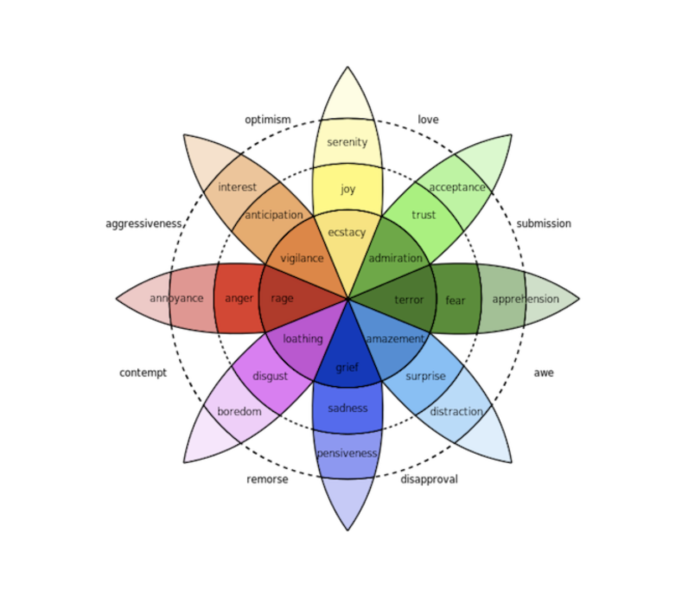When I first ran across the topic, I thought, “Emotional intelligence? Well, we cover that in marketing and talk about it in communication.” I really didn’t do a deep dive into it on an interpersonal level. So, when I started to further investigate emotional intelligence, I saw it as a tool to develop not only myself but also my students. It’s with this perspective that I’ll share with you about the topic of emotional intelligence today.
First, I’ll give you some background on emotional intelligence: What is emotional intelligence? Where did it come from? How did it grow?
Next, I’ll talk about why emotional intelligence is so important for both professors and students.
Finally, we’ll consider some emotional intelligence strategies for the classroom.
And at the very end of this presentation, I have resources you can use for further exploration.
What Is Emotional Intelligence?
The term, “emotional intelligence,” first appeared in 1990. Peter Salovey and John D. Mayer were the principal researchers who developed the framework. David R. Caruso was working with them too, and he helped develop an EQ assessment. As you know, it is possible to measure your IQ (intelligence quotient). There are ways to measure your EQ, as well.
Here is the research team’s definition of the topic:
Emotional intelligence includes the ability to engage in sophisticated information processing about one’s own and others’ emotions and the ability to use this information as a guide to thinking and behavior. That is, individuals high in emotional intelligence pay attention to, use, understand, and manage emotions, and these skills serve adaptive functions that potentially benefit themselves and others.
Emotional intelligence is the ability to look at your emotions and then to ask, “How can I use my emotions to really create great relationships with others? How can I be there to relate with them? How can I be there to empathize with them? And how can I manage my emotional response?”

The idea didn’t get popular until 1995, when Daniel Goleman released his blockbuster book, “Emotional Intelligence.” It was on the New York Times best-seller list, sold five million copies worldwide, and was translated into 30 different languages. That’s when EQ — or ‘EI’ (as Daniel Goleman now likes to refer to it) — really became well known. Goleman took the initial definition from Salovey and Mayer, then expanded upon it. He said emotional intelligence really comes down to specific competencies, and they range across four different areas. We’ll explore all four of those today.
One of the competencies is self-awareness. It describes being aware of yourself, your emotions, your dispositions, your thinking, your thoughts toward things, and how you react and behave. Another is self management — being able to manage yourself in certain situations and being able to manage your emotional responses.

The other side, if you can imagine a line going right through the middle of these, deals with how you relate with others. One is having empathy and social awareness, being aware of how other people feel about things. The final competency is being able to manage your relationships with others.
Goleman says that, nested within these four broad areas, are learned abilities that help us become better leaders and sets performers apart from the average — and that is why I am so excited about this idea. The central point is that emotional intelligence can be developed! You can expand your emotional intelligence, you can become more self-aware, you can better manage yourself, you can become more socially aware, right? And you can manage your relationships, as well.
That’s the beauty of emotional intelligence. It can be developed over a period of time. IQ is a measure of intelligence, and much of the literature says IQ is rather fixed at a certain point in time. You have what you have. With EQ, though, the potential is unlimited.
Why Is EQ Important?
All right, so the question is “Why EQ? Why emotional intelligence? Why are we talking about this, and what’s the point behind it? Let me give some context here. As a professor, you wear many different hats: you’re a researcher, you’re a coach, you’re a teacher, you’re an influencer, and you’re a colleague. On top of those things, you’re also a dad, you’re a mom, you’re a brother, you’re a sister, you’re an aunt, you’re an uncle (or not), you may even be an Olympic hopeful. All of these different roles put demands on us, those demands create emotional responses.
As a dad, I’m filled with pride, but sometimes I’m scared about what my son is going to do. I need to have the proper emotional response. It’s the same thing with students. We look after our students, we love our students, and we want them to become the very best that they can be. That sometimes takes patience on our side. We have to scale ourselves back in order to help them grow and develop the way they’re supposed to.
Here’s an interesting example of this: I follow our very much esteemed colleague, Dr. Scott Cowley, on Twitter. One day, as I was putting together my presentation and looking for some great examples, I saw a tweet by Dr. Cowley that speaks to the essence of emotional intelligence.
Here’s what he said in that tweet:
Roller coaster of a day. Relative going on hospice. Another relative found work after long unemployment. A student left our program. A professor in Europe told me her class loved three of my class projects. A student cried in my office. Let myself get riled by another professor.
The level of emotion that Dr. Cowley experienced through all of these events is amazing. Life’s challenges and demands create emotional responses, and we have to be able to regulate ourselves and choose to be present in the moment, to be the best of ourselves in the moment. That’s really speaking to the essence of emotional intelligence.
These types of situations are challenges. There are challenges, there are setbacks, and there are opportunities that you and your students face every day. There’s an uncertainty about what’s going on, and we need to find a way to be the most productive and most effective people we can be. We need to make the most of our potential and the opportunities we have. That requires a lot of self-management, right, a lot of inner reflection and a steady pace. That’s what emotional intelligence allows.

At the Stukent Digital Summit, Lydia Shah presented a report from Microsoft that listed the top soft skills and the top hard skills most important for marketers in this decade. I think we tend to focus on the hard skills, but give less attention to the soft skills. Yes, the hard skills get our students in the door, but the soft skills keep them there. Check the list (as given by Microsoft) below, and you’ll see what I mean.
Soft skills marketers need
- Creativity
- Humility
- Empathy
- Adaptability
- Transparency
Hard skills marketers need
- SEO
- Data analysis
- Copywriting
- Behavioral analysis
- Automation
The soft skills require emotional intelligence. For example, fear is an emotion, and sometimes we’re fearful of presenting an idea that’s different from everyone else’s idea, right? And, sometimes we don’t know how to empathize with others very well. The ability to adapt and be resilient also requires emotional intelligence. We need to develop and cultivate those types of skills.
In addition, a Microsoft white paper — The Class of 2030 and Life-Ready Learning — says future jobs will depend on social-emotional skills, and the curriculum of future schools will help students learn those skills. Here’s a quote from that paper:
The strongest signal from our study was the need for teachers, schools, and school leaders to help students develop stronger social-emotional skills. While not new in education, these skills are newly important and are taking center stage alongside cognitive skills and content knowledge in the classroom and in the workforce.

Facts can be easily found online, but emotional intelligence skills need to be personally developed. It is the soft skills, the empathetic and personal ways of interaction, that sets humans apart from computers.
EQ Strategies for the Classroom
So, the question becomes, “How can we develop those types of skills in our classroom?’’ A good place to begin approaching that issue is to first consider self-awareness, then look at self-management. After that, we’ll turn to social awareness and social management. We’ll define each and give examples.
EQ and Self-awareness
Self-awareness is the ability to recognize and identify how you feel. There are many different strategies one can employ to become more self-aware, but we’ll cover just a couple of examples. First, if somebody asked you how you feel, how would you reply? Sometimes we respond to that question with what we want to project, not necessarily with how we actually feel. I’ve found that it is sometimes easier for my students to communicate how they feel via emojis than to actually tell me how they feel face-to-face.
The point is that we need to develop more of an emotional vocabulary that will enable us to really dial in on exactly how we’re feeling, and one way to do that is by using a tool like Plutchik’s Wheel of Emotions. By considering the relationships between the primary emotions and related emotions, we can develop an emotional vocabulary to help us tell others how we are feeling.

A quick and creative way to use this in class is to refer to the graphic and ask, “Which color best represents your day right now?” An alternative question is, “Which colors best represent the songs on your playlist?” This exercise gives students a different way to describe how they feel and helps them take an introspective look at themselves. It can help them regulate their emotions and be more present throughout the day.
Of course there are other questions you can use to check in with your students:
- How do you feel about this assignment?
- How do you feel about the digital marketing field?
- How do you feel about social media?
- How do you feel about advertisements?
- What recent developments in society concern you?
Instead of having a reaction, we want to transition to reflection. Once we’re self-aware, we can move to regulating and managing our emotions. This is critical for you, as a professor, and also for your students. The emphasis is on a positive outcome. Once you are aware of your emotions, then you can manage them. The next strategy deals with emotional regulation.
EQ and Self-management
I have a question for you, okay? Would you consider yourself, when it comes to managing your emotions, a thermostat or a thermometer? In other words, can you regulate your emotional response like a thermostat regulates the temperature, or are you more like a thermometer that immediately reacts to any emotional situation? When working with students, do you allow their frustration to frustrate you? When you arrive home after school and you’ve had a tough day, do you allow that to spill over to others in the house?
Here are two in-class ideas to tap into the idea of self-management:
- Ask students to respond to negative consumer reviews. How can they put themselves in the shoes of the business owner and respond to some rather heavy negative consumer reviews?
- Simulate a sales or client proposal rejection in class. Have them run through a proposal, then say “I don’t think this is a good fit for our organization.” Look not just at their verbal response, but at how they manage their emotions.
When we rate presentations, we should not only consider the content presented and the level of detail within the content, but we need to observe whether there is enough enthusiasm in the presentation to really connect with the audience and express their emotions. In marketing, emotion sells.
EQ and Social Awareness
Social awareness is the ability to recognize and identify emotions in others. This is especially important in relationship management, and the number one skill to develop here is empathy. A lot of people confuse empathy with sympathy, so it’s very important to delineate them. Empathy is something you feel with the other person. Sympathy is something you feel for the other person.
Let’s say a student or colleague comes to you and says, “You know, I’m really nervous about this presentation.” A sympathetic response says, “Hey, you got this. No need to worry!” An empathetic response might be, “You sound concerned. What’s making you nervous?” With empathy, you’re trying to relate, you’re trying to identify the problem and see if you can help. Empathy is a key skill for anyone in marketing, not just for people in sales positions.

Here are two ways to bring empathy into your classroom:
- Pair students up to discuss either a horrible or a delightful customer service experience. Have the students practice empathetic responses.
- Ask students to identify emotional statements in product reviews. What terms/emojis are customers using to relate how they feel? Which reviews seem genuine?
Ask follow-up questions on how that particular student felt in that particular customer service experience. Get them to dig into the experience a little more and relate to the customer end of it. Show students how to respond to an angry customer by empathizing first, then offering a solution.
EQ and Social Management
Social management is the ability to develop healthy relationships through self-awareness, self-management, and social awareness. You need all three components in place. You need to be able to know how you feel about the issue and how other people are feeling about the issue. Then you can consider the response you think is best and how you can further develop the relationship.
Ask the students to observe their relationships and look for their own predominant style of communication in social settings. Ask them to see if they can identify cases where they should emphasize a certain communication style. Sometimes, maybe, they should become a little bit more passive — for example, when they don’t know much about the issue or topic. And maybe it would be good to become slightly more aggressive, like when they aren’t being treated justly.
You can also introduce your class to theories of team development. Tuckman’s model of formation — Forming, Storming, Norming, and Performing — provides a useful framework for that discussion. Students tend to hate a lot of teamwork, but we know that teamwork is a key to success in the professional world. We work as a team, and we work in teams, so this is an important skill to develop. By describing the four states of team formation to them, then giving them an assignment that requires teamwork, they’ll be able to recognize the stages as they occur. You can stop them, at various times, and say, “Okay, which stage of team formation are you in now?” That exercise can be powerful.

EQ Quotes and Final Notes
Daniel Goleman says this:
I would say that IQ is the strongest predictor of which field you can get into and hold a job in, whether you can be an accountant, lawyer or nurse, for example. IQ can show whether you have the cognitive capacity to handle the information and complexities you face in a particular field. But once you are in that field, emotional intelligence emerges as a much stronger predictor of who will be most successful, because it is how we handle ourselves in our relationships that determines how well we do once we are in a given job.
Aristotle spoke about emotional intelligence from a slightly different perspective. He wrote this in his classic work, The Art of Rhetoric:
Anybody can become angry, that is easy; but to be angry with the right person, and to the right degree, and at the right time, and for the right purpose, and in the right way … that is not within everybody’s power and is not easy.
Finally, I will end with one more quote, this one by my dad, Dr. Abdul K. Sinno:
At times when all looks dark, remember that hope is stronger than despair, and courage can replace fear. All of these are inside of you, and they are all switchable.
I believe that last quote really speaks to the whole notion of emotional intelligence. Emotions exist within us. We can choose to become more aware of them, and we can manage ourselves so that we can be the best that we can be towards ourselves, towards others, and towards the people we serve.
Suggested Resources for EQ in the Classroom
Collaborative for Academic, Social, and Emotional Learning
Consortium for Research on Emotional Intelligence in Organizations
This article was adapted from Professor Rafic Sinno’s presentation at Stukent’s ProfCon 2020.

Speaker Bio: Rafic Sinno is an associate professor of marketing and assistant department chair of business administration at the University of Dubuque. His teaching emphasizes an interdisciplinary approach in helping students discover and develop their proficiency in the marketing and communication fields. Given his dedication and commitment to teaching, Rafic received the Faculty Member of the Year Award (2017) for outstanding teaching, ability to motivate students, and the earned respect of his peers and the Wendt Faculty Character Advancement Award (2021) for advancing excellent moral character in teaching, learning, or living.
Rafic’s passion and appreciation for photography, lead him to cofound Sinno Communication, a provider of inspirational photography prints and training. Through this venture, he co-authored three market-leading books with his father, Dr. Abdul K. Sinno: Door County: A photographic journey by land, water, and air, Scenic Treasures of the Midwest: Panoramas and Impressions, and The Mississippi River, Border to Border: Panoramas and Impressions.
Before his teaching and entrepreneurial initiatives, Rafic developed and marketed international business and value-added agriculture procurement conferences to further economic development initiatives in Northwest North Dakota. Rafic received his BA in Communication from Clarke University and MBA from the University of Dubuque.






